Techniques Used
To be a successful and effective massage therapist you need a toolbox of techniques and approaches that can help clients in many diverse situations. “If you truly understand the essence of the different styles, East and West can easily be integrated to create a truly powerful bodywork that is unique in its own right.” (Rachel Fairweather, Eastern Massage Approaches)
I use a huge range different techniques in Jing Method™ of Advanced Clinical Massage (ACMT), ![]()
-
-
-
- Range of motion assessment
- Orthopaedic functional muscle testing
- Hot/cold therapy
- Amma Fusion
- Acupressure
- Trigger Point Therapy
-
- Neuromuscular Techniques (NMT)
- Fascial Release: direct & indirect myofascial release
- Manual Therapy
- Stretching: Static or Passive; Proprioceptive Neuromuscular Facilitation (PNF) & Active Isolated Stretching (AIS)
- Physiotherapy techniques
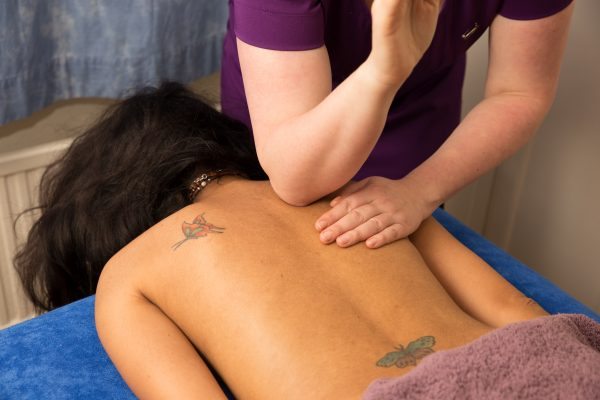
Trigger Point Therapy (TPT)
Trigger Point Therapy is one of the most important basic techniques that I use to treat pain and mobility restrictions. Thanks to the work of Dr Janet Travell, the doctor who pioneered trigger point work in the US, we have a growing body of evidence that many pain conditions are actually caused by trigger points. Studies suggest that trigger points are a component of up to 93% of the pain seen in pain clinics, and the sole cause of such pain as much as 85% of the time (Gershwin; Fishbain quoted in Travell and Simons: Myofascial Pain and Dysfunction: The trigger point manual Volume 1)
What Are Trigger Points?
Trigger points are what many people call ‘muscle knots’ i.e. lumps and bumps in their muscles that are responsible for weakness, pain or restriction of movement. Although they ‘feel’ like knots in muscle they are in fact small areas of tightly contracted muscle. Trigger points are usually associated with pain, and sometimes muscle weakness and restriction of movement.
Referred Pain
If you press on a trigger point it hurts – BUT they may also cause pain elsewhere – this is known as referred pain. Trigger points are therefore split into two types:
- active or primary trigger points – where you immediately feel the pain (even during rest)
- latent, also known as satellite or secondary trigger points, that refer the pain elsewhere in the body
This is important as clients often focus on where the pain is, rather than on where it might be originating, thus not effectively treating it.
For example, you may feel the pain of a migraine or headache across your eyes and forehead, but the trigger point causing it can be located in the sternocleidomastoid muscle in the neck
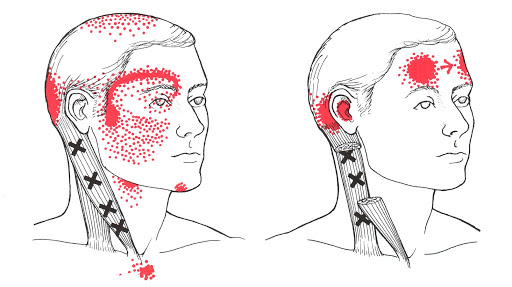
Trigger points in the Sternocleidomastoid muscle in the neck (marked with the X) can cause referred pain patterns across the head and face (marked with red areas)
Another feature of trigger points is local twitch response, in which there may be a momentary muscular spasm or twitching reaction of the taut muscle when it is subjected to pressure. Clients often notice their muscles twitching as I release the trigger points.
They are known to cause or contribute to low back pain, carpal tunnel symptoms, tennis elbow, neck pain, migraines, jaw pain, and many kinds of joint pain mistakenly attributed to arthritis. They can cause sinus pain and congestion, nausea, chronic dry cough and are thought to contribute to fibromyalgia.
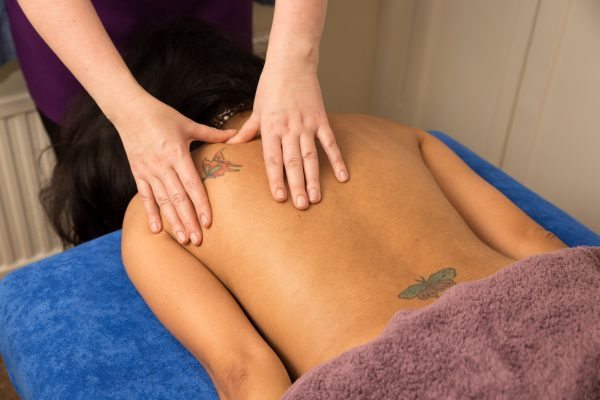
Deep Tissue Massage can be extremely effectively at relieving muscular tension
Neuromuscular Therapy (NMT)
Neuromuscular Therapy is a form of massage technique that is primarily focussed on the trigger points, rather than on massaging the whole body as in Swedish massage. I use my fingertips, hands, elbows and occasionally knees, to explore the tissues and apply perpendicular pressure to the affected muscles. This can be done with the assistance of the client, to locate any trigger points and apply direct pressure using specialized techniques.
This type of massage is similar in some respects to deep tissue massage and is aimed at alleviating muscle stress, and facilitating healing by applying concentrated pressure. As well as bringing relief to trigger points it may also be effective in treating tingling and numbness of limbs due to trapped nerves, neck pain, back pain, joint pain, and repetitive motion injury.
Myofascial Release (MFR)
Fascia is a web-like structure of connective tissue that surrounds and penetrates everything in the body – veins, arteries, muscles, tendons, ligaments and organs. It helps to both hold everything in place and to enable effective movement.
Myofascia is the name for the fascia surrounding muscles in particular, which is why the term is used in massage therapy. I incorporate Myofascial Release techniques into most of my massage treatments and can offer focussed Myofascial Release treatments on request.
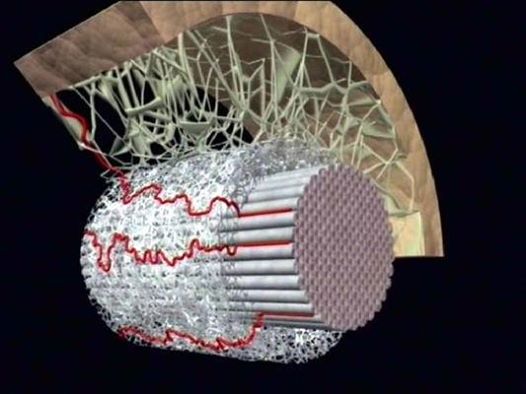
Diagram Showing The Fascia (White Strands And Filaments) Between The Skin And The Muscles
Fascia is made of:
- Ground substance = a gel-like substance which acts as a type of shock absorber
- Elastin = to give it elasticity & return back to shape after stretching
- Collagen = to give it strength
- Water and Lubrication: all that ‘dew like’ liquid on the fascial web is actually water. The human body is 70% water and much of it resides in the fascia assisting to keep it well-lubricated and flexible. This is why keeping well hydrated and drinking plenty of water is so important for maintaining a good range of movement
- Flexibility and Massage: however, in order for any water to reach it you have to keep the fascia, muscles and soft tissue flexible and open in the first place. This is where massage treatments & myofascial release become part of the process for improving your overall fascial, muscular and body condition
More Movement = more we move & stretch = more elastin created = more flexibility
This is why acrobatics, gymnastics, or practicing yoga or pilates leads to greater flexibilityLess Movement = less we move and stretch = more collagen created = less flexibility
This is why the more sedentary we are, the more restricted we can become”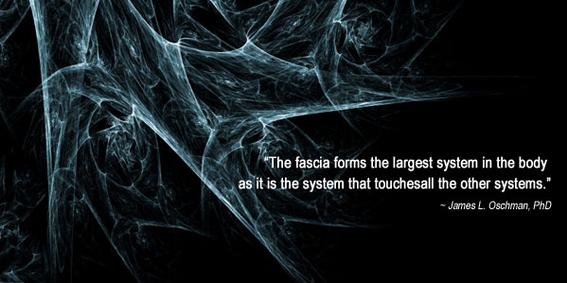
Facial Release is split into two techniques:
Direct Techniques
Direct methods often use fists, fingers, forearms or knuckles to sink and glide through the fascial layers in order to release deep fascial restrictions within and between muscle groups.
Indirect Techniques
In the indirect approach the fascia is put on a stretch or given slight pressure to initiate a response in the tissues. The therapist then literally ‘follows’ where the tissue wants to go with their hands whilst keeping the stretch. After holding the stretch for between 3-5 minutes the tissue will eventually release in the place where it needs to. The effects can feel ‘magical’ with the tissues described as melting like butter!
Amma Fusion Techniques – Meridian Massage & Acupressure Points
The following is taken from “Eastern Massage Approaches” by my tutor, the amazing Rachel Fairweather at Jing Advanced Massage Training
Meridians
Put quite simply, meridians are like the energy “super highways” of the body. The core principle of Traditional Chinese
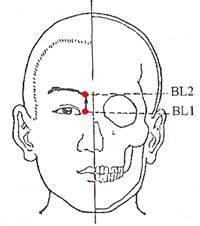
Bladder Meridian Acupressure Points 1 & 2
Medicine (TCM) is that health and illness are directly related to the flow of qi (energy) in the body. If qi (pronounced “chee”) becomes imbalanced in some way (ie: by becoming deficient, excessive or stagnant) dis-ease may result.
From a TCM point of view, energy flows in channels known as “meridians”; traditionally there are 72 channels with 12 major ones used in acupuncture and bodywork. Amma Fusion techniques focus on balancing energy in the body by working these channels through palming/thumbing techniques and a series of dynamic stretches.
Amma Fusion is often successful in treating conditions that do not traditionally respond to Swedish or other standard massage techniques. These include digestive complaints, colds, headaches, sleep disturbances, chronic fatigue, neck or back pain that does not respond to a muscular based approach. It can be used as a stand alone technique or blended with other bodywork styles including myofascial release, stretching, other energy work and trigger point therapy.
Acupressure Points
Amma Fusion also uses knowledge of recognisable points along the meridians where the energy can be easily accessed and balanced. These are known as acu-points or more commonly, acupressure points (“tsubos” in Shiatsu). Amma can be performed over light clothing which is preferable for some clients.
Stretching Techniques
Static stretching, Proprioceptive Neuromuscular Facilitation stretching (PNF), and Active Isolated Stretching (AIS) are all incredibly useful to get results in the effective treatment of pain. Which technique you choose will depend on the needs of the client and the technique they respond to best.
Passive or Static Stretching
The client is passive and does not contribute to the stretch or engage in any active muscle contraction.
On the client’s out breath, I assist until the client can ‘feel the stretch’ and hold this for at least 30-60 seconds. It is extremely important that the stretch is initiated slowly and with client communication. This technique is often used and integrated into a massage session. The longer the stretch is held the more effective the result. The therapist encourages the client to breathe regularly and deeply to help overcome the effect of the stretch reflex.
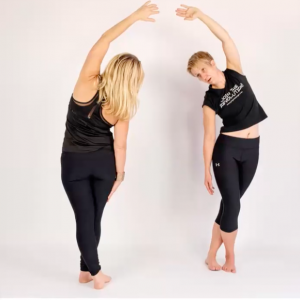
Meg and Rachel at Jing Massage beautifully demonstrating lateral side stretching of the body – this can be wonderful to release the hips
PNF (proprioceptive neuromuscular facilitation)
This is my favourite technique as it has really amazing almost ‘magical’ results in increasing how far the client can move!
On the client’s out breath, I assist until the client can ‘feel the stretch’. When this position is reached, I encourage the client to resist the movement in the opposite direction against my hand. This is done using using 20-30% of their strength for a count of 5. I then take the stretch even further for another few seconds. This position is held and the process repeated 3-5 times or until maximum stretch has been reached.AIS Active Isolated Stretching
This technique, developed by massage therapist and kinesiologist, Aaron Mattes, allows the client to do the stretching. AIS is great for active clients who find traditional stretching boring! The technique has the great three in one approach:
- strengthening the active muscle
- strengthening the passive muscle
- giving the client a slight cardiac workout due to the repetitions
On the client’s out breath, the client takes themselves into a stretch until they can ‘feel the stretch’. The stretch is taken slightly further by assistance from a me or an aid such as a rope or the client’s own hand. The position is held for 1.5 – 2 seconds then the client returns to the starting position. This sequence is repeated 8 -10 times.
This technique improves range of motion, increases and retains flexibility, and strengthens and balances the musculoskeletal system.
-
